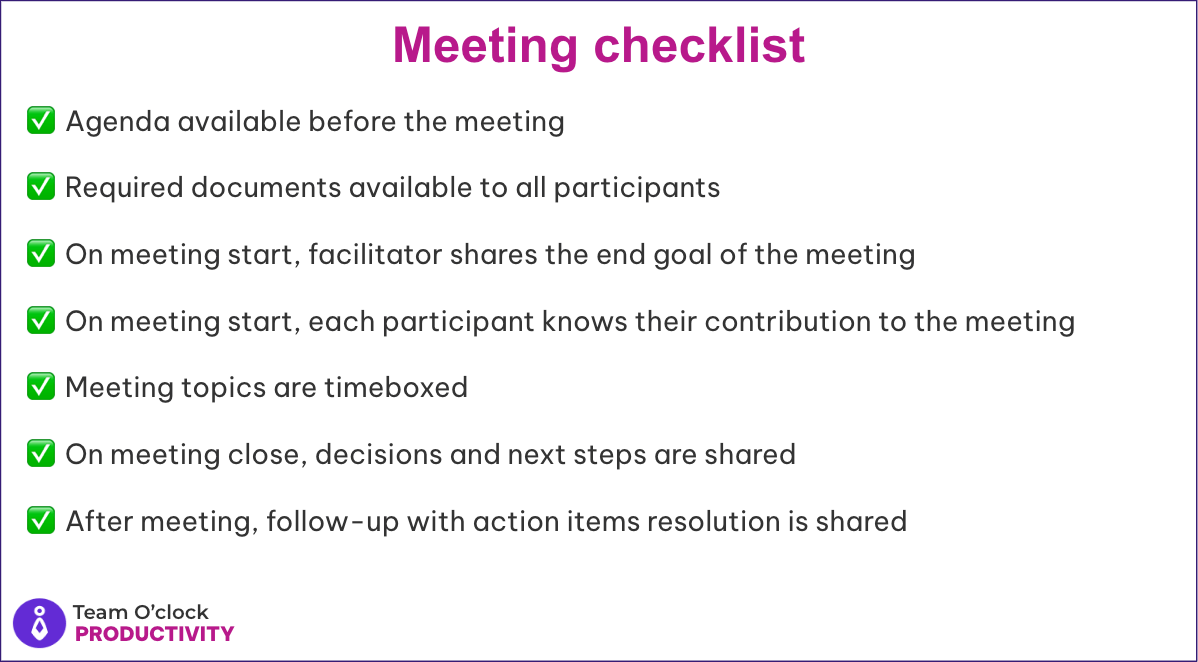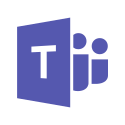
Meeting Less, Doing More: Strategies to Minimize Meetings in Remote Teams

Based on a study by the University of California in 2015, it takes around 25 minutes to recover after a meeting and get back into flow. Considering that we are now way more accustomed to meetings, even assuming that this recovery time is 15 minutes, no meeting will take you less than 40 to 50 minutes; adding up preparation time of at least 10 minutes.
Taking a hypothetical scenario of 4 meetings in a workday, you end up with a bit over 4 hours available for focused work. Adding up your lunch break time, you end up in a state where less than 50% of your time is available for focused work.
Taking the scenario up a notch, a meeting action you will act upon means more work for each meeting. This work adds up to your upcoming workdays. Two or more consecutive days of 4 meetings a day with action items, means that you reach a point where your full workday is filled up with meeting-related work; taking actions, preparing, performing, or recovering from a meeting.
Claiming back your time
With the above exercise in mind, it's safe to say "fewer meetings equals more quality work". Claiming back your time you control your working day and tasks. This means you can plan your workday and define how much time you want to work on a task.
Let's see how you and your team can claim back time.
Embracing Asynchronous or Hybrid Models
Asynchronous and Hybrid communications must be your next friends in a remote team. Let's start with a brief definition and examples:
Asynchronous means that members can share their notes and discuss, each in their own time. There is no need for the team to be simultaneously on the same medium or place to carry over a discussion. Some examples of asynchronous communication you already use are your posts and comments on social channels, your favorite chat app (Slack, MS Teams, Messenger, Viber), and a shared document with many editors.
Hybrid means that part of a discussion is carried out asynchronously (check the definition above) and another part of the same discussion is carried out with the whole team simultaneously on the same medium or place. Hybrid communication and collaboration are a bit harder to share examples of. What follows are some Hybrid models from the wider experiences we all have:
Family dinner is a hybrid model. Some family members are responsible for buying and cooking the food in their own time, then the whole family meets on the table to have dinner. Finally, some family members are doing the dishes and cleaning after.
A retrospective and follow-up are a hybrid model. Team members can share their notes simultaneously or on their own time, then meet to discuss and take action items. Finally, the decided action items are carried out by the whole team or some members at their own time.
The scrum sprint is a hybrid model. The team meets to decide what to include in the upcoming iteration, then each member picks up the work to do on their own, or in smaller groups. The team regroups on daily standups for a sync and finally meets again to present what they have worked on in the iteration in the sprint review.
By reducing real-time communications members can better plan their working hours with fewer dependencies and fewer blockers for other colleagues.
Another benefit of the asynchronous approach is that the whole team knows how to navigate a new issue in a non-meeting way. Essentially, members work on that new issue on the timeframe and mind frame they see fit, vs. a preset time everybody meets and needs to get into the topic.
Implementation tips
Making asynchronous communication a reality needs alignment and definition of the processes across the whole team. Since everybody can work on their own time, it is important to know the rules of engagement and the expectations from everybody else.
Step one to build asynchronous communication is to document the process. Ensure that it is easy and clear to read the process, with just the required steps. This process is a live document you need to update when the team decides to add, modify, or remove a step.
A process document is half the work. What comes next is making this process a habit for all colleagues. "Reading the process document" should be the default thought in everybody's mind. To make it sticky, keep repeating and re-sharing the process document on every occasion. The repetition will convert this process into a habit.
6 questions to help you choose which meetings to skip
Picking meetings to replace with asynchronous collaboration is unique to each team's dynamics. What follows are some questions you can use against a meeting to see if it is a good candidate for asynchronous collaboration:
Is this meeting to inform everybody on something new I'm building? If the answer is "yes", you can avoid this meeting by simply sharing your thoughts in a document and asking everybody to contribute.
Is this a meeting for a status update? Again, if the answer is "yes", you can avoid this meeting by requesting all participants to share their updates asynchronously. If additional clarifications are needed, then you might need a short meeting with fewer participants to discuss or reply in the asynchronous medium you chose in the first place (email, document, async meeting app, chat).
Will we collaborative brainstorm on this call? If the answer is "yes", have the meeting. Still, there are certain parts of the meeting you can perform asynchronously to maximize the impact of being together with the team, e.g. ask participants to share their ideas in a document before the meeting to avoid long monologues during the call.
Is just one person presenting in this meeting? If the answer is "yes", you can choose a different format to share this presentation and request possible feedback, e.g. ask the presenter to record a presentation video and share it with all participants asking for feedback.
Will we be reviewing emails, tickets, and tasks in this meeting? This is a rephrase of "status update" which needs similar asynchronous handling. Answer in comments of tickets or tasks, and reply over email instead of having a call to walk through what the email or ticket is about.
Are we building an action plan in this meeting? If the answer is "yes", this is an important meeting that should not be skipped! Even in the case of an action plan meeting, it makes sense for participants to do their prep work beforehand to avoid long monologues during the meeting.

Streamlining Communication
To remove meetings from your daily schedule, you will need other mechanisms for communication that promote async collaboration and ease any hardcore meeting believer's concern of "losing important messages"!
Good async habits and policies, make the whole team responsible for clear and precise communications. Let's see a few ways to streamline communication.
3 Response policies for more efficient remote team
Stale questions in work chat feed the "meeting beast", driving people to set up a meeting to address unanswered questions! A reply policy in chat that is shared with the whole team helps set response expectations.
An acceptable response time is usually implied - yet never stated. All you have to do is detect and share it with everybody. Depending on the team's maturity, timezones, and speed a response time may vary from an hour up to three work days.
Another response policy I've used a lot has to do with defining the response tool. For cases, where design or development decisions are discussed it is best to keep the whole dialogue in a non-ephemeral tool for future reference. So, decision discussions should be done in project management tools (Jira, Linear, Asana) or docs; not your work chat app.
Talking about response policies, it would be a mishap to skip organizing chat discussions under threads. A thread is a proper way to discuss a topic outside the stream of a channel.
Ensuring compliance with any response policies needs repetition, clear rules, and validation through positive feedback. The response policy is part of a team's DNA and should be built as a habit in the team culture. Document your response policies, to share with the existing team and onboarding new team members.
Make existing meetings efficient
Meeting efficiency builds trust and safety in all participants that "this meeting works! We need it!" The team is more energized by joining a valuable meeting.
Let's see a few ways to optimize your meetings:
Make sure there is an agenda available before the meeting! The structure of the upcoming meeting is like the backbone of a skeleton; it keeps everything from falling apart. If you schedule the meeting, you must create and share the agenda. If invited to a meeting with a missing agenda, request the agenda from the facilitator.
Documents that bring all participants on the same page before the meeting. If reading is required before the meeting starts, either share the documents beforehand or spend time in the meeting to read the material. Jeff Bezos suggests reading as the first part of a meeting to ensure everyone is on the same page; he calls that Start with Silence.
The facilitator shares the end goal of the meeting. The meeting goal is the expected outcome or decision the team should reach by the meeting's end. The meeting goal will be the focus of all discussions. When a discussion is going off-topic any of the participants can reshare the meeting goal to focus the discussion back on topic.
Each participant knows their contribution to the meeting. For a meeting that just started, the facilitator should share what each participant brings to the table. That's a way to ensure that everyone will contribute and not stay silent.
Timebox your meetings will set specific goals and direction for all participants. By timeboxing, you also define the most important items in the agenda; ones that take most of the time.
Close the meeting by repeating the decisions and next steps. Secure time near the meeting's end to summarize the discussion and share any action items. Meeting closure makes or breaks a successful session. The discussion summary calibrates participants on the big topics discussed. Action items ensure the next steps on decisions made.
Follow-up and action items resolution after the meeting ends. Any action item resolution is the trigger of further actions or a follow-up meeting to discuss findings, and further steps ahead on the initial meeting goal.
Following the above methods you will improve any meetings. Implementing these methods requires substantial effort in the beginning - if you haven't done it before - so arm yourself with resilience and keep pushing.

Establishing Boundaries
All sections above are helping you optimize what you know and what you can organize. Yet, the elephant in the room is ad-hoc meetings. When urgency and recency bias kicks in, you need additional external mechanisms to protect you and the team's time.
No Meetings Day, Hours
Specific days or hours as no-meeting times as a team are good methods to keep your focus. That technique is easier said than followed. It requires extreme determination to resist the urgent and ad-hoc.
Follow are some ways to establish the no meeting days or hours:
Block time in your calendar. For example, Google Calendar supports Focus Time as a meeting type, where you can set it to block any incoming meeting requests that overlap automatically.
Add automated work chat app messages to signal the start and end of no meeting time to the whole team.
Define theme days and meeting days that can trigger you to shift any incoming meeting to the specific theme or meeting day, unblocking you from an ad-hoc meeting now.
The impact of establishing and following clear boundaries is big, especially in achieving deep work. Clearing out ad-hoc meetings you secure your focus before and after the meeting, to prepare for the call and get back into the flow of work respectively.
Technological tools to ease mundane manual work
Of course, digital tools can lift tons of trivial work. With the latest technological leap in LLMs and GenAI, we have even more tools to make things much easier.
Starting with the basics - that we shouldn't neglect - we have:
Sharable worksheets, that the whole team can update asynchronously in Google Drive, Notion, Confluence, Team O'clock, and a lot more tools. Each member jumps in at their time of convenience, checking what other people have added, commenting, and adding notes.
Online video or audio calls, for synchronous communication. Provided your colleagues are available at that time you can have a quick chat to solve things out without typing anything.
Work chat apps, for team communications and coordination. You can have a full meeting in a thread at the team's convenience and pace.
Collaboration boards, for team brainstorming like Miro, Figma, Slack Canvas, and many more. The team can lay full concepts and new ideas in a shared freeboard.
Integrations, automation, and scheduling tools to create rules that fit your team's schedule, plan follow-ups, and exchange information between tools. These tools free up your mind from reminders and tasks to manage follow-up, action item reminders, etc.
Going to more specific and recent tools for meetings:
AI summarization for a meeting is a great way to share an overview with everybody or to introduce a follow-up by bringing everyone in sync.
Auto-transcription of meeting notes while the meeting takes place.
Digital facilitators manage structure, the mundane tasks of a meeting, and suggestions leaving the team to focus on communication and messaging.
Today, there are solutions combining more than one tool from the list, making meeting management way easier for your team. Chances are that there is a solution already available that fits your team's needs. For example, with Team O'clock we offer a digital facilitator, a shareable worksheet per meeting, integrations, AI summarization, scheduling options, and AI suggestions and assistance.
Takeaways
As a summary:
Keep in mind the asynchronous and hybrid ways of having meetings
Keep everyone on the same page by sharing the process you are trying out, this will build the habit
Consider response policies and no meeting time as part of the process to set expectations with everybody
Experiment with when you should hold a meeting or not based on each occasion, some great alternatives might come up!
Always come prepared to a meeting to maximize efficiency
Online tools and solutions can assist you in having less and more efficient meeting
Closing, meetings are not the enemy of progress, collaboration, and productivity; bad meetings are! Another closing post advice is, to always question your next meeting; even if the previous time you had the same meeting was awesome, there are things you can improve or even drop altogether if the participants can now align differently.
Keep rocking!

More articles to check

Assist your team's growth with our partnership program:








